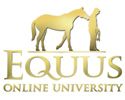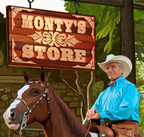I've seen the method with alot of trainers where they use the open hand in round pening as a comunication to the horse saying that that is how cats/preditors communicate. This never made sense to me. If we are trying to gain the horse's trust why are we attempting to act like something that will eat him and not like one of the herd? Shouldn't we be attempting to simulate horse behavior and comunication not preditor?
Rewards
Subscribe to Equus Online University and become a part of Monty's worldwide mission to leave the world a better place for horses and for people too.
Students automatically gain access to special rewards, such as exclusive discounts at the Monty Roberts Online Shop. Visit Monty Roberts Online Shop.




Kit,
I believe this is simply a method of putting pressure on the horse to drive him/her away during join up. Remember you are trying to put your horse in "flight" mode and this is one of the simpler ways to do it. Horses will always flee from a predator.
I actually used it with my Warmblood because I did not have a round pen to work in but a rather large arena. There was no way I could stay close enough to her to use the long line to keep her moving. Using the "paw" in the air worked beautifully. Once you take the "Paw" away and close the hand then it takes pressure off the horse and signals that it is safe for her - and you are the one that made it safe for her helping to build the trust you are looking for. It worked beautifully with my horse.
Hi the two of you! Horses and other prey animals live in the same space in the wild as preditors do, they all have to drink from the same waterhole. So horses have learned to read the bodylanguage of preditors to make sure the moment is safe to drink. In Monty's book "From my hands to yours" drawings are shown of what certain gestures and opening/closing of a "paw" would mean to a horse. As in many parts of this gentle training method the taking away of pressure is the most important part of it. So if you send away and try to get comunication by raising your hand in a paw-like manner, the next more important thing is to close your fingers and make a fist, cross your body axis and become more passive. This is what the horse is looking for and will comunicate his relaxation by lowering his head etc.
To bring the energy down, you sometimes have to bring it up first.
If you try both parts I'm sure you will no longer feel preditory. Give it a try!
Miriam
I understand the pressure and release system I'm a firm believer in it. I also know horses are flight animals and sometimes it's necessary to allow them or even ask them to bring up their energy to get them to relax. I also can clearly see that his horses don't see him as a preditor. I'm just confused because horses push other horses away all the time. And all the horses I've ever been around don't trust preditors. So the thing I don't understand is why preditory body language is chosen over equine body language?
I want to be clear, I'm not disputing that it works I just find it helpful to understand the reasons for things so when I'm working with a problem I'm unfarmiliar with I have more tools to find a solution.
Hi Kit
This is a good discussion topic you have brought up here.
As you point out, horses do push other horses around all the time. This is how they establish their pecking order and school those who misbehave (which you probably already know). They achieve this by putting eyes on eyes, laying their ears back, maybe nipping or kicking all in an effort to drive the offending horse away - whatever it takes to make the one misbehaving fall into line and accept the head mare as leader and their unique position within the heard again. When you think about it, the head mare could be considered to be displaying preditory behaviour when doing this to another horse.
I am no professional, but from what I have read and learnt so far, I believe we are communicating in the language of Equus (the equine language) when we raise our arms (like paws), put our eyes on the horse's eyes and use body language that is preditory to drive the horse away - because this is what the head mare does.
We drive the horse away during the process of Join Up so we can invite the horse to come back to us as a member of our heard and to accept us as leader. Just like the head mare does when her position is challenged or the heard rules are broken.
I have also wondered why this process works, and have now just accepted that it workds because the process of driving away, schooling, inviting the horse back and permitting rest in the comfort of the heard or in the presence of the leader is quite simply the language of Equus.
We don't have ears to lay back, or a lovely long neck to stretch out or arch like our horses do to aid our communication with them, so we have to do what humans need to do to achieve communication in their language eg. shoulders square, raised hands with spread out fingers and use our eyes etc. From my understanding, I believe this is our way of speaking Equus - a human dialect of the horse's language if you will.
Either way, the preditory body language used to apply pressure, followed by the subsequent release of it is definately equine body language because the horses made these principles a part of their day-to-day life.
I hope this is a helpful way of looking at it for you.
Kind regards,
Gen
That is very helpful! Thank you!
Yes very helpful Kit,I also like to look at Klaus Ferdinand Hempfling working, as his body moves get great response from horses.